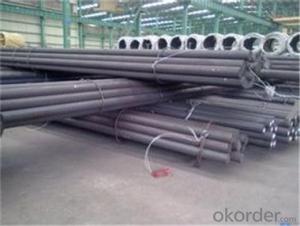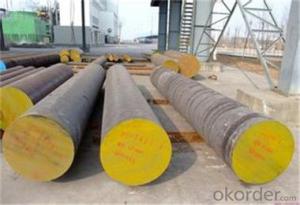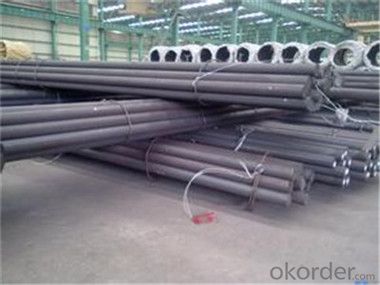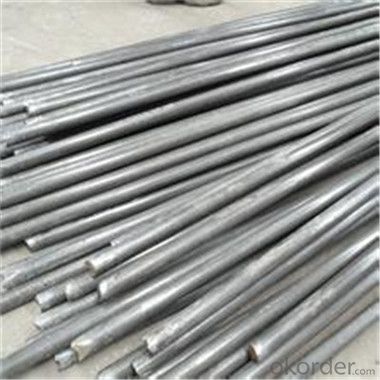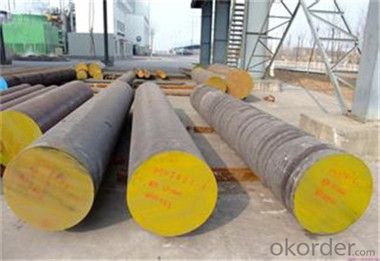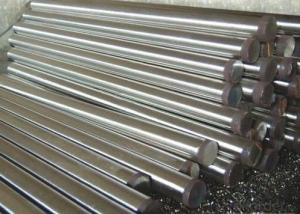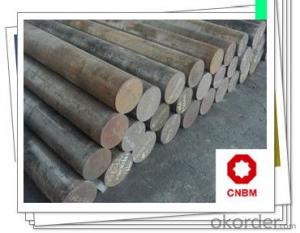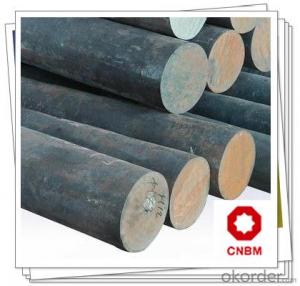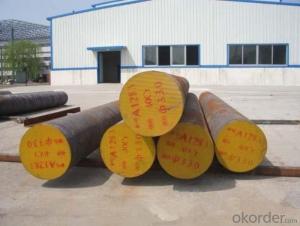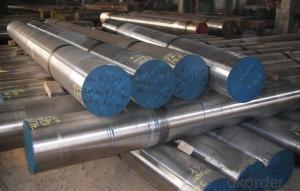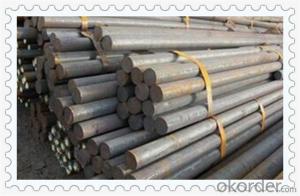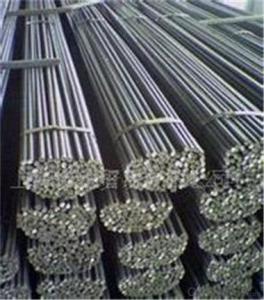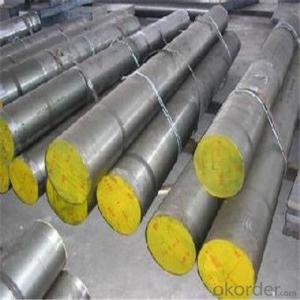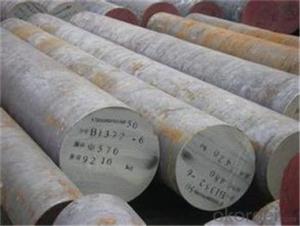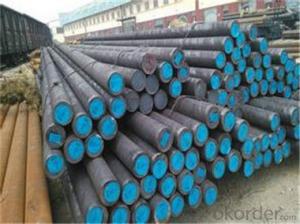Steel Round Bar/High Alloy Round Tool Steel Bar/M2/M25M42/D2
- Loading Port:
- Tianjin
- Payment Terms:
- TT OR LC
- Min Order Qty:
- 44 m.t.
- Supply Capability:
- 2000000 m.t./month
OKorder Service Pledge
OKorder Financial Service
You Might Also Like
Description of steel round bar:
Characteristic:Tungsten-molybdenum high speed steel developed by China,high performance in toughness ,hardness, high temperature hardness.
Festures of steel round bar:
Anneal temperature: 840-860
Relief annealing temperature: 720-760
Hardening temperature: 1210-1230
Specifications of steel round bar:
The highest temperature is 427 degrees Celsius.it has good strength,and high quenching property ,the toughness is good and small deformation during quenching.At high temperature, there are high creep strength and endurance strength.It is used in the manufacture of a higher strength and higher quenching and tempering section of the 35CrMo steel, like big locomotive traction gears, supercharger drive gear, rear axle, the connecting rod and the spring load greatly clip.
| C | Si | Mn | W | Mo | Cr | V | P | S |
| 0.80-0.90 | 0.20-0.45 | 0.15-0.40 | 5.50-6.75 | 4.50-5.50 | 3.80-4.40 | 1.75-2.20 | ≤0.030 | ≤0.030 |
Images of steel round bar:
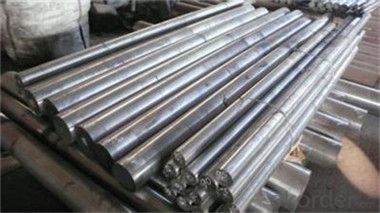
FAQ:
1. What is your package?
Packing situation: standard seaworthy packing or as customer required.
2. How long is the lead time?
Delivery time: 45 days after order confirmed.
- Q: What are the advantages of using duplex steel round bars?
- One of the main advantages of using duplex steel round bars is their superior strength and corrosion resistance. Duplex steel is a combination of austenitic and ferritic stainless steels, which provides a unique combination of properties. This type of steel offers higher strength compared to austenitic stainless steel, making it suitable for applications that require durability and load-bearing capacity. Additionally, duplex steel round bars exhibit excellent resistance to corrosion, especially in harsh environments such as marine or chemical industries. This resistance to corrosion makes them a cost-effective choice, as they require less maintenance and have a longer lifespan. Overall, the use of duplex steel round bars can improve the longevity, reliability, and performance of various industrial applications.
- Q: Can steel round bars be used for making engine parts?
- Yes, steel round bars can be used for making engine parts. Steel round bars are often used in the manufacturing of engine components due to their high strength, durability, and resistance to heat and corrosion. They can be machined into various shapes and sizes to create engine parts such as crankshafts, camshafts, connecting rods, and valves. The use of steel round bars ensures the required mechanical properties and structural integrity needed for engine performance and reliability. Additionally, steel round bars can be heat-treated and surface-treated to further enhance their properties, making them suitable for engine applications.
- Q: Can steel round bars be used for making cutting tools?
- Yes, steel round bars can be used for making cutting tools. Steel is a versatile material known for its strength and durability, making it suitable for various applications including cutting tools. The round bars can be shaped and sharpened to create different types of cutting tools such as knives, blades, or drill bits.
- Q: What are the different surface treatments for steel round bars?
- There are several different surface treatments available for steel round bars, each serving a specific purpose and providing unique benefits. Some of the most common surface treatments for steel round bars include: 1. Hot-dip galvanizing: This process involves immersing the steel round bars in a bath of molten zinc, which creates a protective coating that helps prevent corrosion and rusting. Hot-dip galvanizing is an effective treatment for steel round bars used in outdoor or corrosive environments. 2. Painting: Applying a coat of paint to the surface of steel round bars not only enhances their appearance but also provides a protective barrier against moisture and oxidation. Painting is commonly used for decorative purposes or when a specific color is desired. 3. Powder coating: Powder coating involves applying a dry powder to the steel round bars, which is then cured under heat to form a durable and attractive finish. This treatment offers excellent resistance to impact, chemicals, and UV rays, making it suitable for various applications. 4. Electropolishing: This process uses an electric current and an electrolyte solution to remove a thin layer of the steel round bars' surface, resulting in a smooth and shiny finish. Electropolishing improves the appearance and corrosion resistance of the steel, making it ideal for applications that require a high level of cleanliness and aesthetics. 5. Passivation: Passivation involves treating the steel round bars with an acid solution to remove any free iron or iron oxide from the surface, thus enhancing their corrosion resistance. Passivation is commonly used for stainless steel round bars to increase their longevity and prevent staining or rusting. 6. Shot blasting: Shot blasting is a mechanical surface treatment that involves bombarding the steel round bars with small steel balls or particles at high velocity. This process removes any surface contaminants, scale, or rust, resulting in a clean and roughened surface that improves adhesion for subsequent coatings or treatments. 7. Chrome plating: Chrome plating is a technique where a thin layer of chromium is electroplated onto the surface of steel round bars. This treatment provides excellent corrosion resistance, wear resistance, and a shiny appearance, making it suitable for applications that require durability and aesthetics. Overall, the choice of surface treatment for steel round bars depends on the specific requirements of the application, such as corrosion resistance, aesthetics, or wear resistance. It is important to carefully consider the intended use and environmental conditions before selecting the most appropriate surface treatment for steel round bars.
- Q: Can steel round bars be used for making architectural or decorative elements?
- Yes, steel round bars can definitely be used for making architectural or decorative elements. Steel round bars have various advantages that make them suitable for such applications. Firstly, steel is a durable and strong material, which ensures the longevity and stability of the architectural or decorative element. Additionally, steel round bars can be easily shaped and customized to create intricate designs, making them versatile for various architectural styles and aesthetics. Steel round bars can be used to create features such as railings, balustrades, ornamental gates, sculptures, or even furniture pieces. The smooth and polished surface of the steel round bars also enhances their visual appeal, making them well-suited for decorative purposes. Furthermore, steel is resistant to corrosion, which ensures that the architectural or decorative element will remain intact and aesthetically pleasing even in outdoor or high-moisture environments. In summary, steel round bars are a suitable and popular choice for creating architectural or decorative elements due to their durability, versatility, and visual appeal.
- Q: What are the applications of steel round bars in the aerospace industry?
- Steel round bars have various applications in the aerospace industry, primarily due to their high strength-to-weight ratio and excellent resistance to corrosion. They are commonly used in the construction of aircraft frames, landing gear components, and engine parts. Additionally, steel round bars are employed in the production of critical structural elements, such as wing spars and fuselage sections, ensuring the durability and safety of aerospace vehicles.
- Q: How do you calculate the weight of a steel round bar based on its density and dimensions?
- To calculate the weight of a steel round bar, you need to multiply its density by its volume. The volume of a round bar can be calculated using the formula V = πr^2h, where r is the radius and h is the height. Once you have the volume, simply multiply it by the density of the steel to get the weight.
- Q: Are steel round bars suitable for use in the manufacturing of springs?
- Yes, steel round bars are suitable for use in the manufacturing of springs. Steel round bars are commonly used in the production of springs due to their high strength and durability. The round shape of the bars allows for easy bending and shaping into various spring designs. Additionally, steel has excellent elastic properties, making it ideal for springs that need to absorb and store mechanical energy. Steel round bars also offer good corrosion resistance, which is important for springs that are exposed to environmental elements. Overall, steel round bars provide the necessary characteristics required for the manufacturing of high-quality and reliable springs.
- Q: How do you calculate the moment of inertia for a steel round bar?
- To calculate the moment of inertia for a steel round bar, you can use the formula for the moment of inertia of a solid cylinder. The moment of inertia, usually denoted as I, represents the resistance of an object to changes in its rotation. The formula for the moment of inertia of a solid cylinder is: I = (1/2) * m * r^2 Where: - I is the moment of inertia - m is the mass of the cylinder - r is the radius of the cylinder To calculate the moment of inertia for a steel round bar, you need to know the mass and the radius of the bar. The mass can be determined by multiplying the density of steel by the volume of the cylinder. The volume of a cylinder is given by the formula: V = π * r^2 * h Where: - V is the volume - r is the radius - h is the height or length of the round bar Once you have the mass and the radius, you can substitute these values into the formula for the moment of inertia to calculate it. Remember to convert the units to be consistent (e.g., if the radius is given in centimeters, convert it to meters). It is important to note that the moment of inertia calculated using this formula assumes that the steel round bar is a solid cylinder. If the bar has a different shape or has hollow sections, you will need to consider those factors in your calculation.
- Q: What are the common finishes for steel round bars?
- Steel round bars can be finished in several ways, each offering unique properties and aesthetic appeal. Some of the most common finishes are as follows: 1. Achieving a rough and scaled surface, hot rolling involves rolling the steel at a high temperature. This finish is commonly preferred for applications where a rough texture is desired, such as structural components or machinery. 2. Cold rolling, on the other hand, results in a smoother and more polished surface. It is achieved by rolling the steel at room temperature and is often used in industries like automotive or aerospace, where a clean and precise appearance is required. 3. For a smooth and polished surface, the steel round bar can be turned and polished. This finish involves machining the bar and is commonly used for decorative purposes or in applications where precision is crucial, such as shafts or fasteners. 4. By grinding the steel round bar, any surface imperfections or irregularities can be removed, resulting in a smooth and uniform finish. This finish, known as grinding, is suitable for applications where tight tolerances or a consistent finish are essential. 5. Alternatively, steel round bars can be coated or plated with different materials to enhance their corrosion resistance or aesthetic appeal. Popular options include galvanizing, which involves applying a layer of zinc to protect against rust, or chrome plating, which provides a shiny and attractive finish. Ultimately, the choice of finish for a steel round bar depends on the specific requirements of the application, such as the desired appearance, corrosion resistance, or mechanical properties needed.
Send your message to us
Steel Round Bar/High Alloy Round Tool Steel Bar/M2/M25M42/D2
- Loading Port:
- Tianjin
- Payment Terms:
- TT OR LC
- Min Order Qty:
- 44 m.t.
- Supply Capability:
- 2000000 m.t./month
OKorder Service Pledge
OKorder Financial Service
Similar products
Hot products
Hot Searches
